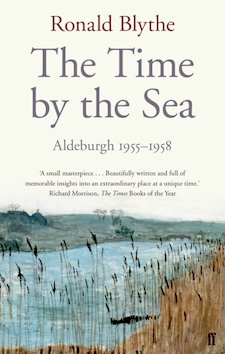Inspiring Older Readers
 posted on 25 Sep 2025
posted on 25 Sep 2025
The Time by the Sea: Aldeburgh 1955-58 by Ronald Blythe
This is the third time I have tried to read Ronald Blythe’s 2013 memoir, The Time by the Sea and each time I have found it an infuriating and frustrating book shot through with beauty. It consists of a series of short, interlinked vignettes, memories of the years he spent as a sort of slave-of-all-work to Benjamin Britten’s Aldeburgh Festival.
It’s frustrating, I think, primarily because I know too little about Blythe himself, too little about Suffolk and the coast and its history and culture, too little (far too little) about Britten and Pears and the circle gathered around them, too little about modern classical music, church architecture, mid-century painting – you name it – and this is one of those somewhat scrappy, gossipy, plunging-straight-in kind of books, with no quarter given at all by Blythe, who seems to assume that readers will instinctively know the characters he is talking about and will already be aware of their cultural or historical significance. There is a glossary of sorts of key characters at the end of the book, but it is far from complete, annoyingly laid-out and to my mind the book needs far more than this. But Blythe was a modest and self-effacing man and to some degree this is reflected in the kind of book this is and in its style: it is clearly intended to be read – as it was written – with pleasure, rather than for scholarly instruction. It is deeply evocative of a vanished time and a vanished world, but its vignettes are sometimes so glancing, so oblique, that it is difficult to know who or what is being spoken of.
Blythe, whose career spanned seven decades, wrote prolifically, publishing novels, short stories, essays and philosophical reflections and contributing hundreds of pieces – largely about rural life and history – to the Church Times; he died aged 100 in 2023. But he remains best known for Akenfield, published in 1969, his fictionalised oral history of an East Anglian village. This became an unexpected bestseller when Penguin published the paperback and Peter Hall’s 1974 film was shown on TV where it attracted an audience of over fifteen million viewers.
Blythe’s life would be spent in a kind of productive but meditative obscurity, deep in the Suffolk countryside, where he had inherited the painter John Nash’s Tudor longhouse, Bottengoms. (After John Nash’s wife, Christine, died in 1976, Blythe cared for the artist, whose health was failing rapidly.) Blythe would go on to live for almost fifty years at Bottengoms, tending to the garden the Nashes had cultivated and to the ancient house they had brought back to life. It was bequeathed to the Essex Wildlife Trust following Blythe’s death.
Blythe’s memoir involves a gallery of artistic and cultural figures – writers such as Mervyn Peake, J. R. Ackerley, Elizabeth Bowen, Sylvia Townsend Warner and Vikram Seth; masters of European photojournalism such as Kurt Hutton, Simon Guttmann (the emigré founder of photo-agency Dephot) and Cartier-Bresson; artists such as John and Christine Nash, Cedric Morris and Mary Potter; and of course the presiding geniuses of the Aldeburgh Festival itself, Benjamin Britten, Peter Pears and Imogen Holst.
For the right reader, it is a treasure trove. And I wish that reader were me. But this is one of those books where I felt defeated by my own ignorance. I said it is a book shot through with beauty and there are glistening, truly evocative nuggets – the scouring winds, the ever-present sea, the memories of painters and poets and musicians and photographers – but too often I found myself feeling unengaged, as if eavesdropping on a conversation (and one that at times seemed heavy with name-dropping). Blythe also hints in various places that some of the locals – agricultural workers and fishermen, shop-keepers and small traders, but even some of the other local artists – viewed the ever-expanding festival as a kind of encroachment, a cultural colonisation, and I’m afraid I also found that a difficult feeling to escape.
But oddly, it is sometimes the books we can’t quite manage to read that have us making repeated efforts to unlock their mysteries and that is how I feel about this book. If the place, the period, the music, art or literature of mid-50s Aldeburgh are of interest, then you’ll find much to enjoy in this memoir. Despite its frustrations I still find Blythe himself an intriguing and oddly attractive figure and I shall almost certainly return to it.
Alun Severn
September 2025